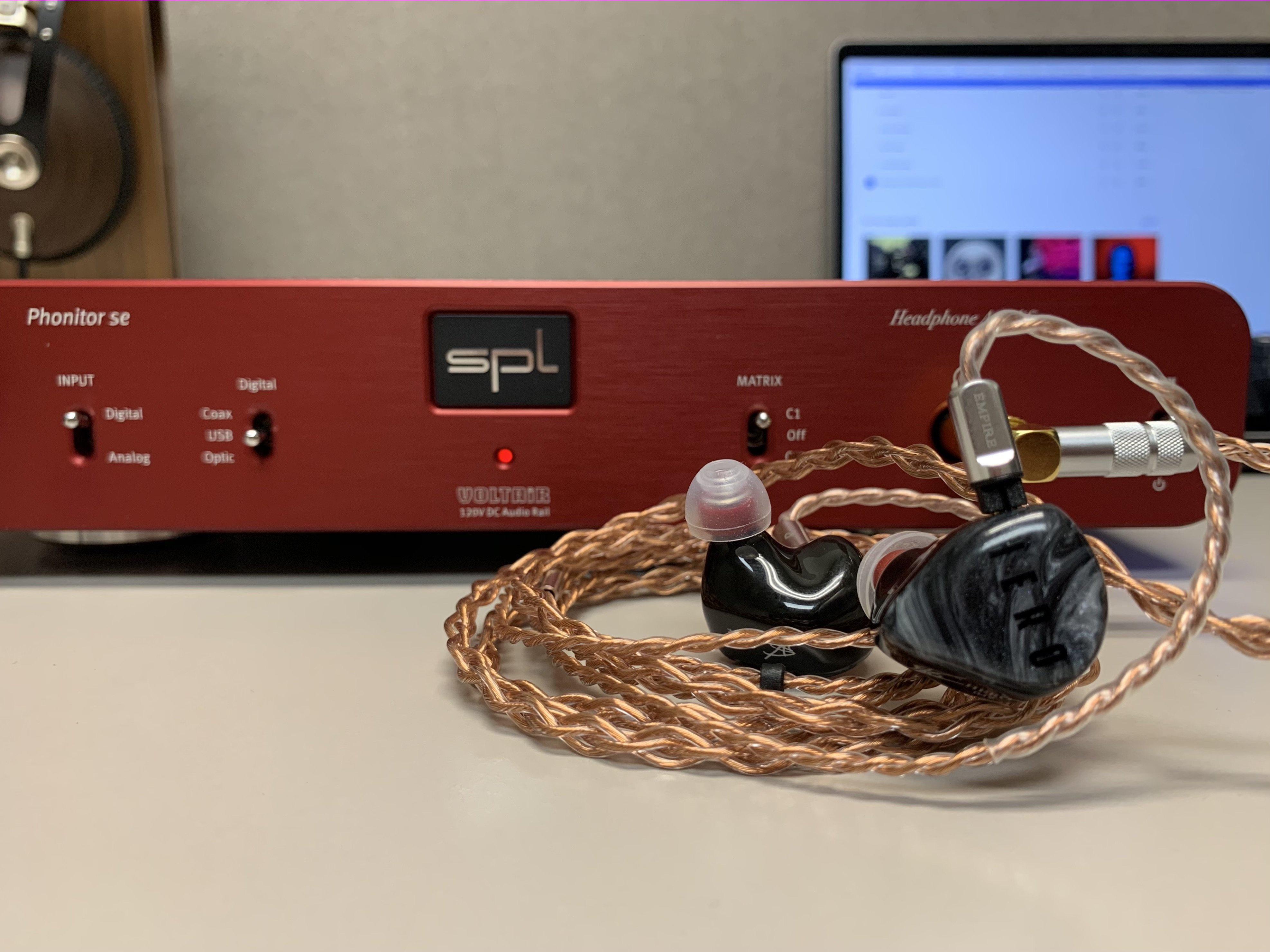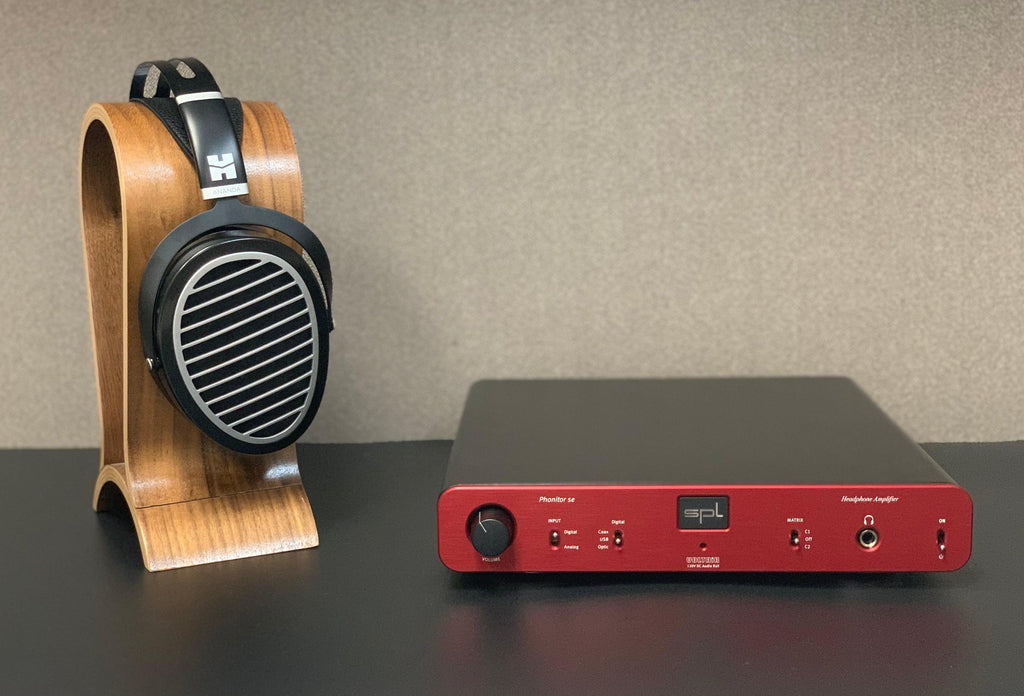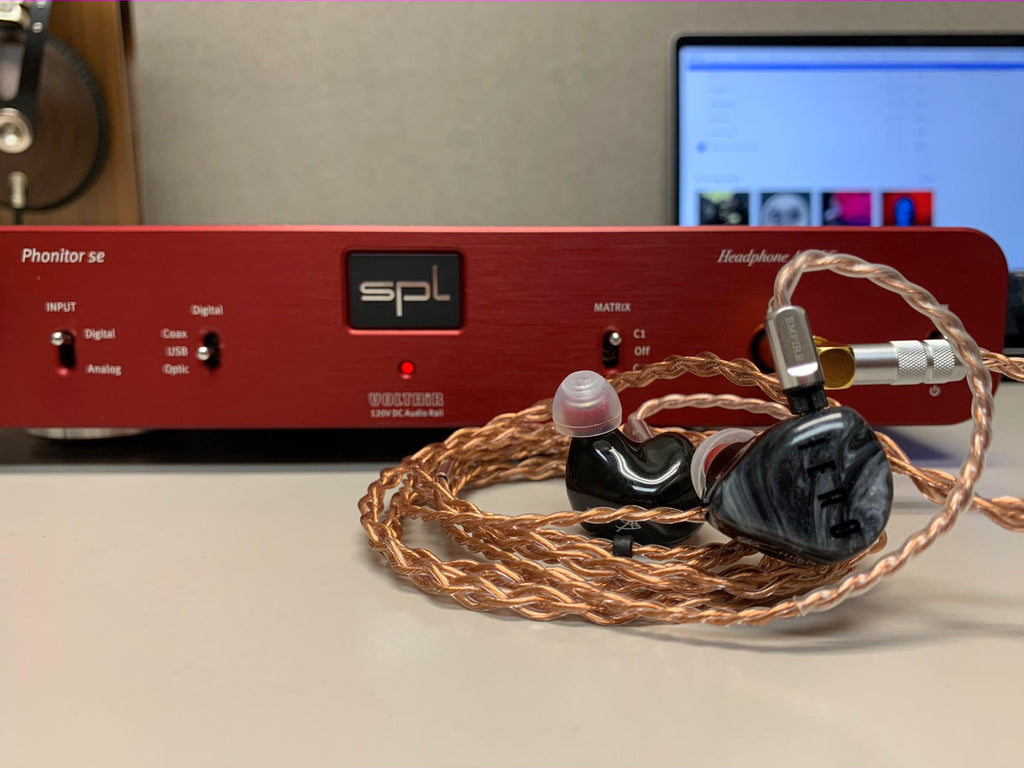Not to be confused with the common audio measurement of Sound Pressure Level, Sound Performance Labs (SPL) is a German company dedicated to making high end audio equipment. While their main focus is reference equipment for studio applications, they also have the Professional Fidelity line of products intended for discerning consumers looking for studio quality sound in a home audio package. The Phonitor series of amps has been the backbone of the Professional Fidelity lineup, and the Phonitor SE is the latest model in that lineup.
The Build and Design
SPL’s designs generally favor function, with solid construction and well spaced, clearly labeled controls. The Phonitor SE fits neatly into that design philosophy. The unit is primarily made from aluminum with an all black chassis, and a faceplate that comes in black, silver, or red. On the front you’ve got the on/off switch, Digital/Analog input, Digital source selection (if you have the DAC built in, otherwise it’s only analog), the Matrix/Crossfeed switch, and a 6.3mm headphone jack. Underneath the unit there’s also a hidden high gain switch. All of the switches and knobs have a firm satisfying feel, and SPL’s description of the volume knob being like “stirring honey in a pot” is apt (and also explains why I get hungry every time I adjust the volume).
The rest of the package is pretty barebones. When you open the box, you get the amp itself, the manual, and a power cable. That’s it. If you got the DAC version, it doesn’t come with a USB cable, nor does it come with RCA cables for either version. But what it does come with is tons of power and a killer sound.
The Sound
Owing to its studio heritage, the philosophy behind the Phonitor SE is very much about creating “a wire with gain.” Under the hood, SPL’s Voltair technology provides tons of clean quiet power, and with that power comes little to no coloration. It’s very clear that the goal of SPL’s engineers was to create a product which provided as honest a sound as possible, with loads of detail. If you pair it with a reference/analytical tuned headphone like the HIFIMAN Arya or Audio-Technica ATH-ADX5000, it’s going to feel a bit dry out of the gate. But the more you dig in, the more you can hear the prowess and power of the Phonitor SE.
One of the first things that really started to stand out was the amount of control and cohesion it demonstrated in the low end. The bass extension is very flat and linear, but even with bass heavy headphones like the Meze 99 Classics, it never feels muddy, and the bottom end is delivered with detail and precision. The impact is also excellent, and can provide plenty of slam when appropriate.
The mids are strong, though I think the built-in DAC might demonstrate some weakness here where the amp’s performance is stronger. With the DAC768sx chip, there’s a small amount of bloat in the low mids on more complicated tracks, but using the amp only with another capable DAC or preamp source, like the line out from an Astell&Kern SE200, everything cleans up nicely, and the mids become that much more clear and revealing.
The treble is bright and clear, providing a good sense of air and space. I found it to be revealing but not harsh or sibilant, even when paired with headphones like the HIFIMAN Ananda which might lend towards sibilance sometimes.
SPL’s Crossfeed Matrix is one of the key technologies used in the Phonitor line. Crossfeed Matrix is intended to improve the soundstage of your headphones and provide an experience that is closer to listening to speakers. There are two different options which are intended to represent different speaker positions in the room. I thought the effect was especially noticeable with IEMs, and also beneficial with closed-back headphones, but I didn’t really feel much of an improvement with the open-back headphones I tested.
All of the technical aspects of the combo are quite strong, and I also found it delivered plenty of power and headroom, with the volume knob never needing to crack the halfway point. The soundstage is moderate to large, but not massive. The noise floor was exceedingly low, and the Phonitor SE can be used with most IEMs, though the most sensitive still create some low noise. Headphones with strong detail retrieval are well served with the amount of detail the Phonitor SE can provide, along with the transparency with which it delivers those details. The dynamics are excellent, providing a soft delicate touch where you need it, and powerful roar when appropriate.
For testing, I had the version with the DAC768sx built in, but I also tested it using a handful of other DAC/Preamp sources to get a gauge of what each was adding to the sound. For the next section, I was actually able to test the Phonitor SE with the DAC sections from both the Burson and Questyle units to get a really good feeling for how each compares. The DAC’s tuning seems similar in purpose to that of the amp itself, which is to say that its response is highly neutral and flat. While it lacks the vibrancy of something like a Chord Hugo 2, it provides a technically solid, uncolored delivery.
Comparison: Burson Conductor 3XP, Questyle CMA Twelve
As luck would have it, we currently have three desktop headphone amps in the $1000-$1500 range available for audition in the office right now. In addition to the Phonitor SE, we have the Burson Conductor 3XP, and the Questyle CMA Twelve. For the most part, all three provide excellent performance, but with different pros and cons compared to each other.
In terms of general build quality and design, all three are top notch. The CMA Twelve and Phonitor have “safer” more traditional designs, with the Conductor 3XP having more unique styling. While the three units have slightly different proportions – with the Burson being the thickest and the Questyle being the widest – the Phonitor is the largest overall.
For features and configuration, the Conductor 3XP is the only one with a screen that provides any sort of digital configuration, and along with that the only one with any real amount of configuration available for the tone and output of the device, beyond selecting input/output channels or high/low gain. In terms of input options, while the CMA Twelve provides a number of input options, the Phonitor SE is the only one to provide a simple RCA input for using the device in amp only mode. On the flipside, the CMA Twelve and Conductor 3XP both have XLR and RCA outputs that can be used for DAC/Preamp only mode, but the Phonitor SE is strictly for headphone output.
In terms of sound, the Burson Conductor 3XP demonstrated a larger soundstage than the Phonitor SE, and a slightly warmer more musical tuning. The Conductor has more bass but without the Phonitor SE’s feeling of intense low end control. In the treble, the Conductor just can’t match the Phonitor’s delicate presentation of the highs.
The CMA Twelve provides a closer match to the Phonitor SE in terms of its overall studio-like performance. The difference comes in that the mids feel better supported on the Phonitor, while the CMA Twelve has a bit more air and space. While both strike me as highly transparent, by comparison, the Phonitor SE seems to me to be the more truly honest of the two, while the CMA Twelve has just a hint of color to it. Almost like the Phonitor gives you the original photo, while the CMA Twelve runs “Automatically Adjust Light and Color” first.
Overall, all three are strong performers, which offer slightly different takes on what you might be looking for in a headphone amp. The Phonitor SE provides the most honest sound, even when honest is quite as exciting, while the Conductor 3XP and CMA Twelve both have their charms as well. In terms of pure, unadulterated headphone amp though, the Phonitor SE is tough to beat.
The Bottom Line
The Phonitor SE gives you the sound: simple, pure, and unadulterated, with every detail intact. If you want power to drive your headphones, lot’s of power – and you want the sound, the whole sound, and nothing but the sound, the Phonitor SE delivers.








